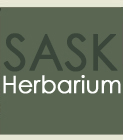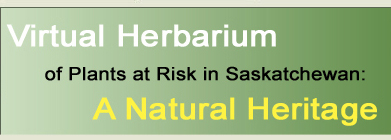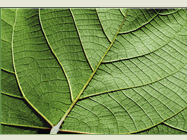|
| Ranunculus inamoenus
var. inamoenus Greene |
|
| |
| TAXONOMY |
| |
| Family: |
Ranunculaceae |
| Genus: |
Ranunculus |
| |
| Species Synonyms: |
Ranunculus affinis var. micropetalus
Greene
Ranunculus inamoenus var. typicus L. Benson |
| Common Names: |
graceful buttercup |
| |
| DISTRIBUTION |
| |
| Canada: |
Yukon – Mackenzie District – Keewatin
District – Arctic Island, south to British Columbia – southwestern
Alberta – northwestern Saskatchewan – northern Manitoba –
northern Ontario – Ungava – eastern Quebec – Labrador
– northern Newfoundland |
| Saskatchewan: |
northeastern Saskatchewan; Lake Athabasca |
| Ecoregion: |
Athabasca Plain |
| |
| HABITAT |
| |
| Saskatchewan: |
moist grassy ravine slopes, lakeshores, and open
woods |
| Associated Species: |
Labrador buttercup, largefruit biscuitroot, little
larkspur |
| |
| RARITY STATUS |
| |
Provincial
Status According
to Harms (2003): |
Endangered |
| Nature Conservancy
Status: |
G5 S1 |
Saskatchewan
Species at
Risk Status: |
None |
| COSEWIC Status:
|
None |
| |
| Graceful buttercup
is endangered because of rarity in Saskatchewan. It is regionally restricted
to the southwestern part of the province. Possible threats have been identified
for this species. |
| |
| SPECIES
DESCRIPTION |
| |
| Height: |
5 – 30 cm |
| Roots: |
slender |
| Stems: |
perennial, erect, long-hairy or hairless |
| Leaves: |
basal leaves persistent, 1 – 4 cm long,
1 – 3.5 cm wide, oval to round, generally undivided or 3 – 5-lobed,
base acute to rounded, tip rounded, margins entire or round-toothed; stem
leaves differing from basal leaves, divided, segments 3, narrow |
| Inflorescence: |
flowers 3 – 7 per stem; receptacle elongating
in fruit to form a head of fruits, heads cylindrical |
| Flowers: |
stalks slender, appressed-hairy; receptacle long-hairy
or hairless; sepals 3 – 5 mm long, 2 – 3 mm wide, spreading
or reflexed, hairy below; petals 5, 4 – 9 mm long, about twice as
long as sepals, 2 – 5 mm wide, yellow; nectary scale hairless; stamens
numerous; carpels numerous on a receptacle |
| Fruits: |
fruits grey-hairy or hairless; beaks 0.5 –
1 mm long, straight or hooked |
| |
| RANUNCULUS
KEY FOR SPECIES FOUND IN SASKATCHEWAN |
| |
| 1 Petals white; aquatic plants with
all leaves submersed |
R. aquatilis var. diffusa |
| 1 Petals yellow; mostly terrestrial
plants or not strictly aquatic (except R. gmelinii) |
2 |
| |
|
2 Fruits with 3 or 4 longitudinal
nerves; leaves round-toothed; plants with runners
|
R. cymbalaria |
| 2 Fruits not nerved longitudinally;
leaves various; plants without runners |
3 |
| |
|
| 3 Basal leaves entire to slightly
lobed, upper leaves similar or absent |
4 |
| 3 Basal leaves distinctly toothed,
lobed or divided OR if entire, stem leaves deeply lobed or cleft and unlike
the basal leaves OR basal leaves absent |
5 |
| |
|
| 4 Leaves linear and essentially bladeless
or blades linear |
R. flammula var. reptans |
| 4 Leaves with well-developed lance-shaped
to oval blades |
R. flammula var. ovalis |
| |
|
| 5 Sepals 3 or 4; leaves kidney-shaped |
6 |
| 5 Sepals 5; leaves of various shapes |
7 |
| |
|
| 6 Plants at least partially aquatic,
< 5 cm high; leaves to 1 cm wide; fruits not constricted, nearly beakless |
R. hyperboreus var. hyperboreus |
| 6 Plants terrestrial, 10 – 20
cm high; leaves to 5 cm wide; fruits constricted near the middle, beak hooked |
R. lapponicus |
| |
|
| 7 Plants strictly aquatic, weak stems
floating |
R. gmelinii |
| 7 Plants not strictly aquatic |
8 |
| |
|
| 8 Beaks of fruits minute, fruit corky-thickened
towards base; plant fleshy; lower leaves stalked |
R. sceleratus |
| 8 Beaks of fruits distinct, fruit
not corky-thickened towards base; plants not fleshy; lower leaves more or
less all sessile |
9 |
| |
|
| 9 Basal leaves entire to round-toothed
or shallowly 3 – 5-lobed, stem leaves cleft or divided |
10 |
| 9 Basal leaves deeply dissected, the
lobes often toothed |
15 |
| |
|
| 10 Hairs on sepals reddish-brown,
long; stems usually 1-flowered |
R. nivalis |
| 10 Sepals hairless or white-hairy;
stems usually 2 – many-flowered |
11 |
| |
|
| 11 Fruiting heads cylindrical |
12 |
| 11 Fruiting heads nearly round |
13 |
| |
|
| 12 Fruits to 150 per aggregate, finely
hairy; plants hairy; petals 5 – 9 mm long |
R. glaberrimus var. ellipticus |
| 12 Fruits to 50 per aggregate, hairless;
plants hairless; petals 6 – 15 mm long |
R. rhomboideus |
| |
|
| 13 Petals 1.5 – 3 mm long; basal
leaves kidney-shaped |
R. abortivus |
| 13 Petals greater than 3 mm long;
basal leaves circular or heart-shaped |
14 |
| |
|
| 14 Flower stalks stout; petals 8 –
15 mm long; stems and leaves long-hairy |
R. cardiophyllus |
| 14 Flower stalks slender; petals 3
– 8 mm long; stems and leaves nearly hairless |
R. inamoenus var. inamoenus |
| |
|
| 15 Fruits slightly flattened, beaks
slender; receptacle in fruit 4 times its length in flower |
R. pedatifidus var. affinis |
| 15 Fruits very strongly flattened,
beaks stout; receptacle in fruit < 3 times its length in flower |
16 |
| |
|
| 16 Petals 5 – 15 mm long, noticeably
longer than sepals; sepals spreading; terminal segment of larger leaves
sessile |
R. acris var. acris |
| 16 Petals 4 – 5 mm long, shorter
than or barely surpassing sepals; sepals reflexed; terminal segment of larger
leaves stalked |
17 |
| |
|
| 17 Stems reclining or prostrate, often
rooting at lower nodes; petals equalling or longer than sepals, deep yellow;
sepals purplish; heads of fruits ovoid to round |
R. macounii |
| 17 Stems erect, not rooting at the
nodes; petals shorter than sepals, pale yellow; sepals yellowish; heads
of fruits cylindrical |
R. pensylvanicus |
|






